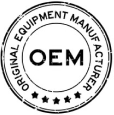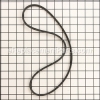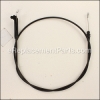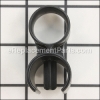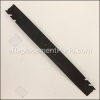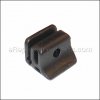This is a Genuine Manufacturer Approved replacement part used on some Push Lawn Mowers. This part is sold individually. The Traction Cable engages drive wheels on the lawn mowers. It is connected to the Traction Bail and then attached to the traction bracket near the transmission.
Traction Cable 105-1844
OEM part for: Toro
Part Number: 105-1844
Jump To:
Frequently Purchased Together ?
Compatibility
This Traction Cable will fit the following 65 machines. Confirm this part works with your model, and view the detailed model diagrams and repair help we have to offer.
Displaying 20 of 65 matching models.
65 total model matches. Try the above search to narrow your results.
This is the official OEM part for the following brands:
- Lawn Boy
- Toro
This item works with the following types of products:
- Lawn Mower
Customer Part Reviews ?
- 1
- 2
Questions & Answers ?
Our customer Service team is at the ready daily to answer your part and product questions.

Ask our Team
We have a dedicated staff with decades of collective experience in helping customers just like you purchase parts to repair their products.
Does this fit my product?Questions & Answers for Traction Cable
Customer Repair Instructions ?
All our customer repair instructions are solicited directly from other customers just like you who have purchased and replaced this exact part.
The traction cable hook at the handle end broke; needed to replace the whole traction cable
Tool Type
Lawn Mower
Difficulty
Medium
Time
15-30 minutes
Tools Used
Pliers, Socket set, Adjustable Wrench, Needle nose Pliers, Vise Grip Pliers
Parts Used
1. Remove the left rear wheel adjacent to the point where the cable spring attaches.
2. Take off the bolt holding the side of the Brace Plate (part number J-25 on the Rear Axle diagram, it\'s really a metal bar across the rear of the housing) off from the same left side as the wheel from step 1. Move the bar away from the area where the spring attaches.
3. Unhook the spring from the axle assembly.
4. Pop off the plastic hole cover (Plug Dome, part I-27) to give more room to remove the old cable.
5. Remove the spring end of the old cable from the mower housing by pulling it out from the top of the housing. Loosen the screw on the Upper Anchor-Cable attachment (part H-17) and slide out the remaining upper end of the cable by pulling it down toward the housing. Discard the old cable.
6. Insert new cable spring from the top of the mower housing.
7. Using needlenose pliers, attach spring to axle assembly hole. (A lot easier said than done, but it eventually goes in.)
8. Put WD-40 on all parts.
9. Pop the plastic re-inforcement part on the new cable into the housing hole. Slide it over and reattach Plug Dome.
10. Re-attach Brace Plate from Step 2 with bolt onto housing.
11. Re-attach wheel from Step 1. Set mower upright.
12. Slide upper end of cable through Upper Anchor-Cable attachment from the bottom. Do not tighten yet. Pull it through until you can complete the next step.
13. Insert top end of traction cable (metal hook end) into handle hole.
14. With mower handle in non-started position, pull Traction Cable from below the Upper Anchor-Cable attachment until it is taught above the Upper Anchor-Cable attachment. Tighten screw on Upper Anchor-Cable attachment. Ensure cable functions correctly when you depress the power handle.
15. Repair complete!
Traction cable broke at the handle, Model 20017
Tool Type
Lawn Mower
Difficulty
Medium
Time
More than 2 hours
Tools Used
Pliers, Socket set, Wrench Set
Parts Used
One: When attaching the new cable to the transmission, rather than only bringing the spring far enough to try attach the spring/hook into that small hole on the lever that controls the transmission, pull enough cable through so that you can easily attach the spring/hook into the hole form the underside of the lever. Once attached just fish the excess cable back through the opening on the mower deck.
Two: The curved end of the cable that attaches at the handle does NOT attach at the same location on the left side of the handle as does the cable on the right side of the handle. If you attach to this location the mower will only move forward when you pull back on the handle. The cable attaches underneath the sliding handle. You will see a lever under the handle that it will attach to.
Lawn mower traction cable (the cable that controls the drive wheels) broke on my Toro Personal Pace mower.
Tool Type
Lawn Mower
Difficulty
Medium
Time
1-2 hours
Tools Used
Screwdriver, Socket set, Wrench Set
Parts Used
Removed the old cable by
using a socket wrench to remove the cable hold from the handle bar,
Removed the Z clip by hand,
Turned the mower on it's side and used a screwdriver to remove the cover for the access hole
Removed the cable spring from the transmission clip
Removed the cable hold from the mower deck using pliers (had to use a good deal of force)
Ran new cable (spring side) through the deck access hole
Attached cable spring to transmission clip (somewhat difficult because of limited access)
Run cable through cable guide on handle post
Run cable through cable hold that will attach to handle bar post but do not attach it to the handle bar post yet
Attach Z end to handle bar
Push cable hold onto the hole in the mower deck (will snap in)
Make sure cable is routed correctly
Reattach cable hold to handle bar post
Make sure you do this in the correct sequence otherwise you will find yourself taking it apart and redoing it. This is the first time I had to make this repair and as such, it was a learning experience, if I have to do it again it will go easier and faster. This is a good repair to do yourself. Be aware that when you have the mower on it's side it will likely leak a little oil and gas, so it's good to do with an empty or near empty tank and be sure to check the oil level when you are finished.
The Traction-Cable parted in the middle
Tool Type
Lawn Mower
Difficulty
Medium
Time
15-30 minutes
Tools Used
Screwdriver, Pliers, Wrench Set
Parts Used
Only a bit of difficulty with hooking the end of cable through eyelet.
Tool Type
Lawn Mower
Difficulty
Easy
Time
15-30 minutes
Tools Used
Screwdriver, Pliers, Socket set, Adjustable Wrench, None
Parts Used
Traction cable broke
Tool Type
Lawn Mower
Difficulty
Hard
Time
30-60 minutes
Tools Used
Pliers, Socket set, Wrench Set, Adjustable Wrench
Parts Used
2. Disconnected wheel bracket from frame
3. Remove broken cable
4. Install new cable
5. Hook end of spring to arm
6. Reattach wheel bracket
7. Put wheel in place
Traction cable broke
Tool Type
Lawn Mower
Difficulty
Medium
Time
Less than 15 minutes
Tools Used
Screwdriver, Pliers
Parts Used
The traction cable broke and the cutout fell out and was cut up
Tool Type
Lawn Mower
Difficulty
Easy
Time
15-30 minutes
Tools Used
Screwdriver, Pliers
Parts Used
2) rolled mover over
3) removed old cable with a long nose vice grip
4) place the new cable onto the traction mechanism
5) connected the top of the cable to the handle
6) adjusted the cable to make the forward motion correct.
Lawn Mower Self Propel cable broke
Tool Type
Lawn Mower
Difficulty
Medium
Time
30-60 minutes
Tools Used
Screwdriver, Pliers, Socket set, Wrench Set
2. Measured cable length. Removed deck plug and cable above the deck and disconnected the spring from below the deck.
3. Remove the rear plastic chute assemble four nuts/bolts and two top deck screw(to allow easy access for spring installation).
4. Installed spring below deck and cabling above deck.Install deck plug.
5. Adjusted cable length to original dimensions.
6. Installed rear plastic chute assembly.
7. Reconnected spark plug and readjusted cabling length for appropriate personal pace operations.
Cables were broken
Tool Type
Lawn Mower
Difficulty
Easy
Time
15-30 minutes
Tools Used
Socket set, Wrench Set, Nutdriver
Parts Used
installed new cables and replaced blots and nuts
Adjusted cable position as needed and tighten nut that held cable in place
OEM stands for Original Equipment Manufacturer and means the part you’re buying is sourced directly from the manufacturer who made your product. At eReplacementParts, we sell only genuine OEM parts, guaranteeing the part you’re purchasing is of better design and of higher quality than aftermarket parts.
Learn MoreOur product descriptions are a combination of data sourced directly from the manufacturers who made your product as well as content researched and curated by our content & customer service teams. This content is edited and reviewed internally before being made public to customers.
Our customer service team are at the ready daily to answer your part and product questions. We have a dedicated staff with decades of collective experience in helping customers just like you purchase parts to repair their products.
All our part reviews are solicited directly from other customers who have purchased this exact part. While we moderate these reviews for profanity, offensive language or personally identifiable information, these reviews are posted exactly as submitted and no alterations are made by our team.
All our customer repair instructions are solicited directly from other customers just like you who have purchased and replaced this exact part. While we moderate these reviews for profanity, offensive language or personally identifiable information, these reviews are posted exactly as submitted and no alterations are made by our team.
Based on data from past customer purchasing behaviors, these parts are most commonly purchased together along with the part you are viewing. These parts may be necessary or helpful to replace to complete your current repair.
All our installation videos are created and produced in collaboration with our in-house repair technician, Mark Sodja, who has helped millions of eReplacementParts customers over the last 13 years repair their products. Mark has years of experience in selling and repairing both commercial and residential products with a specialty in gas-powered equipment.
This data is collected from customers who submitted a repair instruction after replacing this exact part. Customers can rate how easy the repair was to complete and how long it took. We aggregate this data to provide a repair rating that allows customers to quickly determine the difficulty and time needed to perform their own repair.


